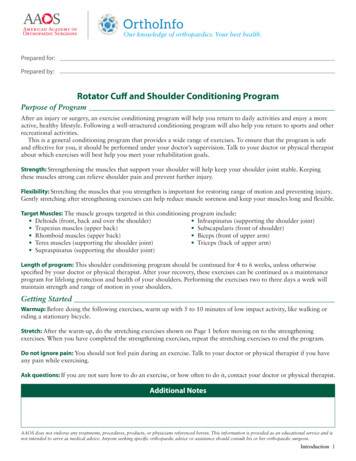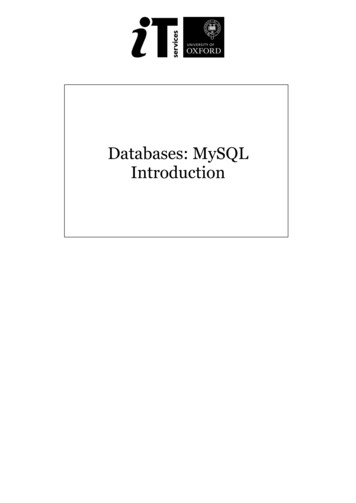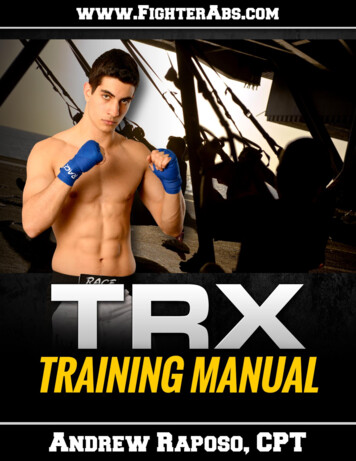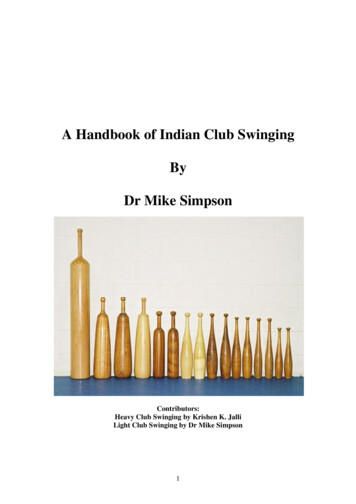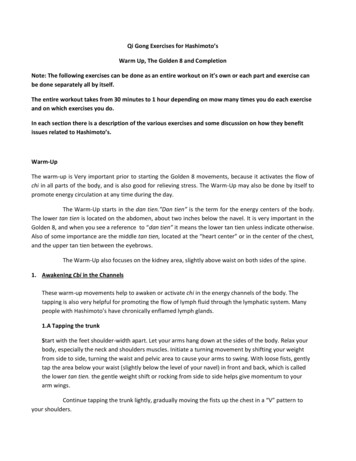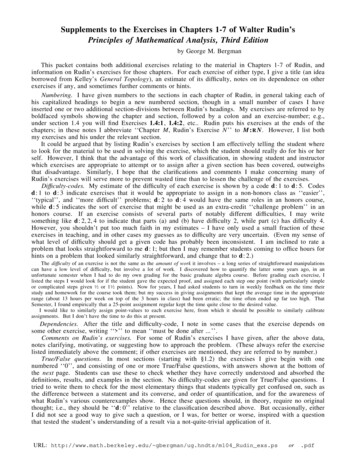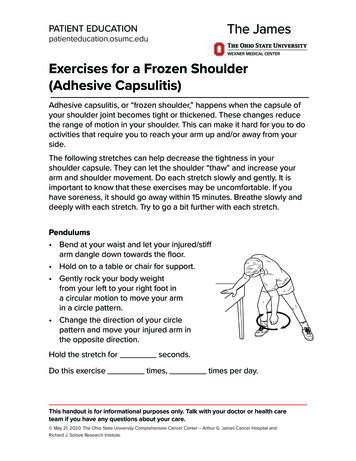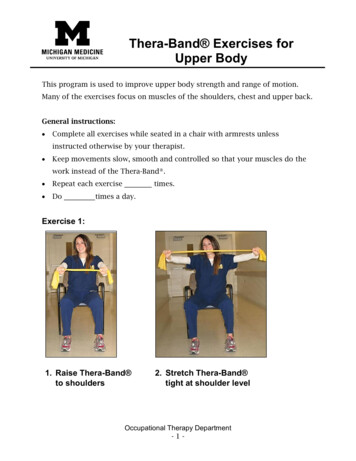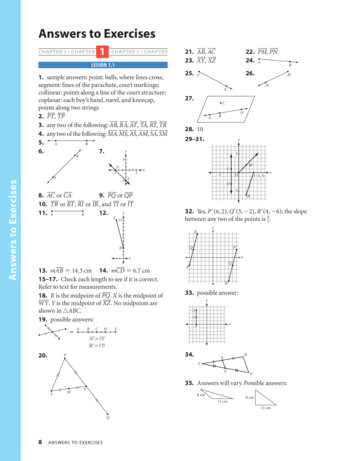
Transcription
Answers to Exercises1CHAPTER 1 CHAPTERCHAPTER 1 CHAPTERLESSON 1.11. sample answers: point: balls, where lines cross;segment: lines of the parachute, court markings;collinear: points along a line of the court structure;coplanar: each boy’s hand, navel, and kneecap,points along two strings , TP 2. PT , RA , AT , TA , RT , TR 3. any two of the following: AR 4. any two of the following: MA,MS,AS,AM,SA,SM5.6.AB7.K , PN 22. PM24. A25.26.YMN27.CDBA28. 1029–31.y53LM3Cx or CA or QP 8. AC9. PQ or RT , RI or IR , and TI or IT 10. TRy11. A12.BS11O–5–3 EA (4, 0)xD–5B32. Yes, P (6, 2), Q (5, 2), R (4, 6); the slopebetween any two of the points is 14 .yRQRP xxQ 14.3 cm 14. mCD 6.7 cm13. mAB15–17. Check each length to see if it is correct.Refer to text for measurements. . X is the midpoint of18. R is the midpoint of PQ . No midpoints areWY . Y is the midpoint of XZshown in ABC.19. possible answers:orABCDPR 33. possible answer:yQNxPE CE AC BC CD20.34.PRATGY35. Answers will vary. Possible answers:SMT8 cm8 cm11 cm11 cmQ8BXyD–3Answers to Exercises , AC 21. AB , XZ 23. XYANSWERS TO EXERCISES
USING YOUR ALGEBRA SKILLS 11. (3, 4)2. ( 9, 1.5)3. (5.5, 5.5)4. ( 6, 44)5. Yes. The coordinates of the midpoint of asegment with endpoints (a, b) and (c, d ) are founda c by taking the average of the x-coordinates, 2 ,b dand the average of the y-coordinates, 2 . Thus thea c b d midpoint is 2 , 2 .6. (3, 2) and (6, 4). To get the first point oftrisection, sum the coordinates of points A and Bto get (9, 6), then multiply those coordinates by 31 toget (3, 2). To get the second point of trisection, sumthe coordinates of points A and B to get (9, 6), thenmultiply those coordinates by 32 to get (6, 4). Thisworks because the coordinates of the first pointare (0, 0).7. Find the midpoint, then find the midpoint ofeach half.8a. Midpoints for Figure 1 are (5.5, 6.5); forFigure 2, (16, 6.75); and for Figure 3, (29.75, 5.5).8b. For these figures the midpoints of the twodiagonals are the same point.Answers to ExercisesANSWERS TO EXERCISES9
LESSON 1.21. TEN, NET, E; FOU, UOF, 1; ROU, UOR, 2N2.A24.135 D67.5 22 22 A67.5 D26. noBGE25.T3.CCYDI4.NSAM27.LAnswers to Exercises5. S, P, R, Q; none in the second figure6. possible answer:B28.CAD7. 90 8. 120 9. 45 10. 135 11. 45 12. 135 13. 30 14. 90 15. Yes; m XQA m XQY 45 90 135 ,which equals m AQY.16. 69 17. 110 18. 40 19. 125 20. 55 21. SML has the greater measure becausem SML 30 and m BIG 20 .22.A30. One possibility is 4:00.H31.90 86OT32.THR33.SATG44 A23.I90 1029.BANSWERS TO EXERCISESN
34.WOBT45. 180 km. The towns can be represented bythree collinear points, P, S, and G. Because S isbetween P and G, PS SG PG.12 cm46.6 cm47.I35.37.39.41.43.MY; CK; m Ix 54 z 32 242 no36.38.40.42. SEU; EUO; MOy 102 288 They add to 360 .6 cm4.36 cm2.18 cm2.18 cm48. MS DG means that the distance betweenM and S equals the distance between D and G.MS DG means that segment MS is congruentto segment DG. The first statement equates twonumbers. The second statement concerns thecongruence between two geometric figures.However, they convey the same information andare marked the same way on a diagram.49. Answers will vary. Possible answer.C70 4 cmAnswers to Exercises40 ABF44. You will miss the target because the incoming angle is too big.40 D70 6 cmETargetMirrorLaser lightsourceANSWERS TO EXERCISES11
LESSON 1.31–3. possible answers:D1.45 O2.GTER3.11. The measures of complementary angles sumto 90 , whereas the measures of supplementaryangles sum to 180 .12. No, supplementary angles can be unconnected, while a linear pair must share a vertex anda common side.13a. an angle; measures less than 90 13b. angles; have measures that add to 90 13c. a point; divides a segment into two congruentsegments13d. a geometry tool; is used to measure the sizesof angles in degrees14.EBPCBIG4.Answers to ExercisesAG and CD intersect at point P so that P isIf ABbetween A and B, and P is between C and D, then APC and BPD are a pair of vertical angles.15. trueDSM5.A16. trueP6.ERDA17. trueBEC7.40 A18. false50 B8.19. false140 40 C D9. B is a Zoid. A Zoid is a creature that has in itsinterior a small triangle with a large black dottaking up most of its center.10. A good definition places an object in a classand also differentiates it from other objects in thatclass. A good definition has no counterexamples.12DANSWERS TO EXERCISES
20. false28. One possible answer is A( 8, 8), B( 4.5, 6.5),C( 11, 1).50 yAB50 80 6SC21. true–12x–6T22. false; Though the converse is true, acounterexample isCTR29. 12 cm30. 36 31. possible answer:A23. falseAnswers to Exercises32.140 0 pt.C1 pt.D40 24. false2 pt.A3 pt.33.C1 pt.2 pt.T25. possible answers: ( 3, 0), (0, 2), or (6, 6)26. possible answers: (2, 3) or (5, 1)27. The reflected ray and the ray that passesthrough (called the refracted ray) are mirrorimages of each other. Or they form congruentangles with the mirror.AReflectedsegmentBMirror4 pt.3 pt.5 pt.6 pt.Infinitelymany points120 1 2 , 34a. 360 3 3 left60 1 1 , 34b. 360 6 6 missing360 34c. 9 40 ANSWERS TO EXERCISES13
LESSON 1.41. FI and IVE ANC18. PA19. possible answer:130 2. possible answers:130 130 5 cm20. possible answer:Answers to Exercises3.4. octagon5. hexagon6. heptagon7. pentagon8–10. One possible answer for each is shown.8. pentagon FIVER9. quadrilateral FOUR10. equilateral quadrilateral BLOC11a. a polygon; has eight sides11b. a polygon; has at least one diagonal outsideof the polygon11c. a polygon; has 20 sides11d. a polygon; has all sides of equal length12. One possibility is C and Y are consecutive and YN are consecutive sides.angles; CY13. 9; possible answer: , AD , BD , BE , CE 14. AC15. TIN16. WEN17a. a 44, b 58, c 3417b. m T 87 and m I 165 14ANSWERS TO EXERCISES21. 84 in.22. 5.25 cm23. AB 14 m, CD 25 m24. complementary angles: AOS and SOC;vertical angles: OCT and ECR or TCE and RCO25.EABCFD26. possible answer:52027. All are possible except two points.0 pts.1 pt.3 pts.4 pts.5 pts.6 pts.
16. possible answers:LESSON 1.51. D3. C5.2. A4. B6. CCC14 cm10 cm40 A7.TSMLABAF10 cmR40 CA8. possible answer:2a2ab – 2ab6 cmB40 6 cmAB40 yCC(–3, 5)(2, 4)10. possible answer:C(–4, 1)(1, 1)x4 cm22. ( 4,1) ( 3, 2) (1,1) (2, 2) (2, 4) (3, 1) ( 3, 5) ( 2, 2) Yes, the quadrilaterals arecongruent.23. Find the midpoint of each rod. All themidpoints lie on the same line; place the edgeof a ruler under this line.24–26. Sample answers for 24–26PP24.25.80 A4 cmB11. possible answer:A4 cm120 P4 cmZ12. possible answers: ( 1, 1), ( 1, 0), or ( 4, 3)13. possible answers: (3, 3), (3, 4), ( 11, 4),( 11, 3), ( 0.5, 0.5), or ( 7.5, 0.5)14. possible answers: ( 3, 1), ( 1, 9), (2, 2),(4, 8), (0, 1), or (1, 6)15. possible answers:CEAN26.ETANQUDATC7 cm12 cm45 A9 cmB45 A9 cmBANSWERS TO EXERCISES15Answers to Exercises9. possible answer:AE17. true18. true19. False, a diagonal connects nonconsecutivevertices.20. False, an angle bisector divides an angle intotwo congruent angles.21. true3a3a10 cm
LESSON 1.61. first figure: quadrilateral ABCD with twocongruent sides and one right angle; secondfigure kite EFGH; third figure: trapezoid IJKLwith two right angles; fourth figure parallelogramMNPQ2. B3. D4. F5. C6. A, D, FI7. DZ8.19b. Possible answer: Rotate one triangle so thata congruent pair of sides forms a diagonal of aparallelogram.20. There are three possibilities: a rhombus, aconcave kite, or a parallelogram.ONEBFAnswers to Exercises9.LAE21a. right triangles21b. isosceles right triangles22.UQ10.TH23.IR5 cm5 cmG11.24.12. square13. possible answers: (2, 6), ( 2, 4); (6, 2),(2, 4); (3, 1), (1, 3)14. 90 cm15. (5, 6)16. S(9, 0), I(4, 2)17. S( 3, 0), I( 1, 5)18. A(7, 6), N(5, 9) or A( 5, 2), N( 7, 1)19a. Possible answer: Flip one triangle and align itso that a congruent pair of sides forms a diagonalof a kite.16ANSWERS TO EXERCISES72 72 72 72 72 25. noyC (0, 5)B (4, 4)xA (5, 0)
LESSON 1.71. Answers will vary. Sample answers:The greenarea in the irrigation photo is a circle,the water is aradius,and a path on the far side of the circle appearsto be tangent to the circle.The wood bridge is an arc ofa circle,and the railings are arcs of concentric circles.The horizontal support beam under the bridge isa chord. , BD , EC , EF 2. three of the following: AB 3. EC , EP , FP , BP , CP 4. AP , AE , AB , BC , CD , DF ,5. five of the following: EF EB , ED , FC , AC , DB , AF , AD , BF or EFC , EBC or EAC 6. EDC , FEC , DEC , . . .7. two of the following: ECD , EDFBPQA17. equilateral; 3 to 1s18.19. yes; yesAnswers to Exercises , HB 8. FG9. either F or B10. possible answers: cars, trains, motorcycles;washing machines, dishwashers, vacuum cleaners;compact disc players, record players, car racing,Ferris wheel 110 ; mPRQ 250 11. mPQ12.16. Equilateral quadrilateral. (The figure isactually a rhombus, but students have not yetlearned the properties needed to conclude that thesides are parallel.)y55–5x65 –5215 20. yes; no13. possible answers: concentric rings on crosssections of trees (annual rings),bull’s-eye or target,ripples from a rock falling into a pond.14.y5–55x–521. no; no15.y8PQ816xANSWERS TO EXERCISES17
22. 80 . The slices of pizza do not overlap, so60 x 140 , where x is the measure indegrees of the angle of the second slice.23.24. not possible25.C60 60 32. not possible33. RGT34.AB27. about 0.986 28. 15 29.4a 2b35.T100 50 36.Answers to Exercises120 BC70 IPEA37.50 70 2p2pF30.120 60 120 A26.A31.U2p55 2pQE120 TRKTI18ANSWERS TO EXERCISES120 60
22. False. The two lines are not necessarily in thesame plane, so they might be skew.LESSON 1.81.2.3.4.23. true5.6.7.8.24. true25. true29. 60 boxesAnswers to Exercises3410.26. False. They divide space into seven or eightparts.53411.12.27. true13. B, D15. C17. A18.19.20. true21. true28. ( 3, 1)14. B16. D29. perimeter 20.5 cm; m(largest angle) 100 30.8 cm120 13 cmANSWERS TO EXERCISES19
18. pyramid with hexagonal baseLESSON 1.91. Sample answer: Furniture movers mightvisualize how to rotate a couch to get it up anarrow staircase.2. yes 3. WO M E N ; Nadine is ahead.4. 28 posts5. 28 days6. 0 ft (The poles must be touching!)B7.20. pyramid with square baseABA21. x 15, y 2722. x 12, y 423.8.Answers to Exercises19. prism with hexagonal baseA9.A3 cmB3 cm24.3 .15.16.TrianglesObtuseIsoscelesnoC ( 2, 3), A (0, 0), B (0, 5), D ( 2, 1)Y ( 4, 1), C (3, 1), N (0, 3)(x, y) (x 3, y 2) CP , EF GH ; i k, j kABperimeter 34 cm25.26.28.30.32.34.point, line, plane ABvertex CD AB ABCcongruent to20ANSWERS TO EXERCISES AB ABprotractor CD AB35. The distance is two times the radius.rrPQPQ 2r36. They bisect each other and are perpendicular.A17. Left photo: Three points determine a plane.Middle photo: Two intersecting lines determine aplane. Right photo: A line and a point not on theline determine a plane.27.29.31.33.PQB
CHAPTER 1 REVIEW1.2.3.4.5.6.7.8.true .False; it is written as QPtrueFalse; the vertex is point D.truetrueFalse; its measure is less than 90 .false; two possible counterexamples:TYEAP30.31.ADAPRCDA29.PPBCT APD and APCare a linear pair. APD and APCare the same angle.EYACBAnswers to Exercises9. true10. true11. False; they are supplementary.12. true13. true14. true15. False; it has five diagonals.16. true17. F18. G19. L20. J21. C22. I23. no match24. A25. no matchT26.32.D33.34.2 in.5 in.3 in.35.125 36.K40 27.S53T728.OP37.ANRIEGANSWERS TO EXERCISES21
38.39.40.41.42.43.44.45.46.47.114 x 2, y 1x 12, y 4x 4, y 2.5x 10, y 8AB 16 cm96 105 30 51. He will get home at 5:46 (assuming he goesinside before he gets blown back again).52. (2, 3)53.Quadrilateral54.Rectangle Square Rhombus55.Answers to ExercisesTrapezoid48. 66 inches49. 3 feet50. The path taken by the midpoint of the ladder isan arc of a circle or a quarter-circle if the ladderslides all the way from the vertical to the horizontal.57.ShedPath of flashlight2256.ANSWERS TO EXERCISES
12 ANSWERS TO EXERCISES Answers to Exercises LESSON 1.3 1–3. possible answers: 1. 2. 3. 4. 5. 6. 7. 8. 9. B is


